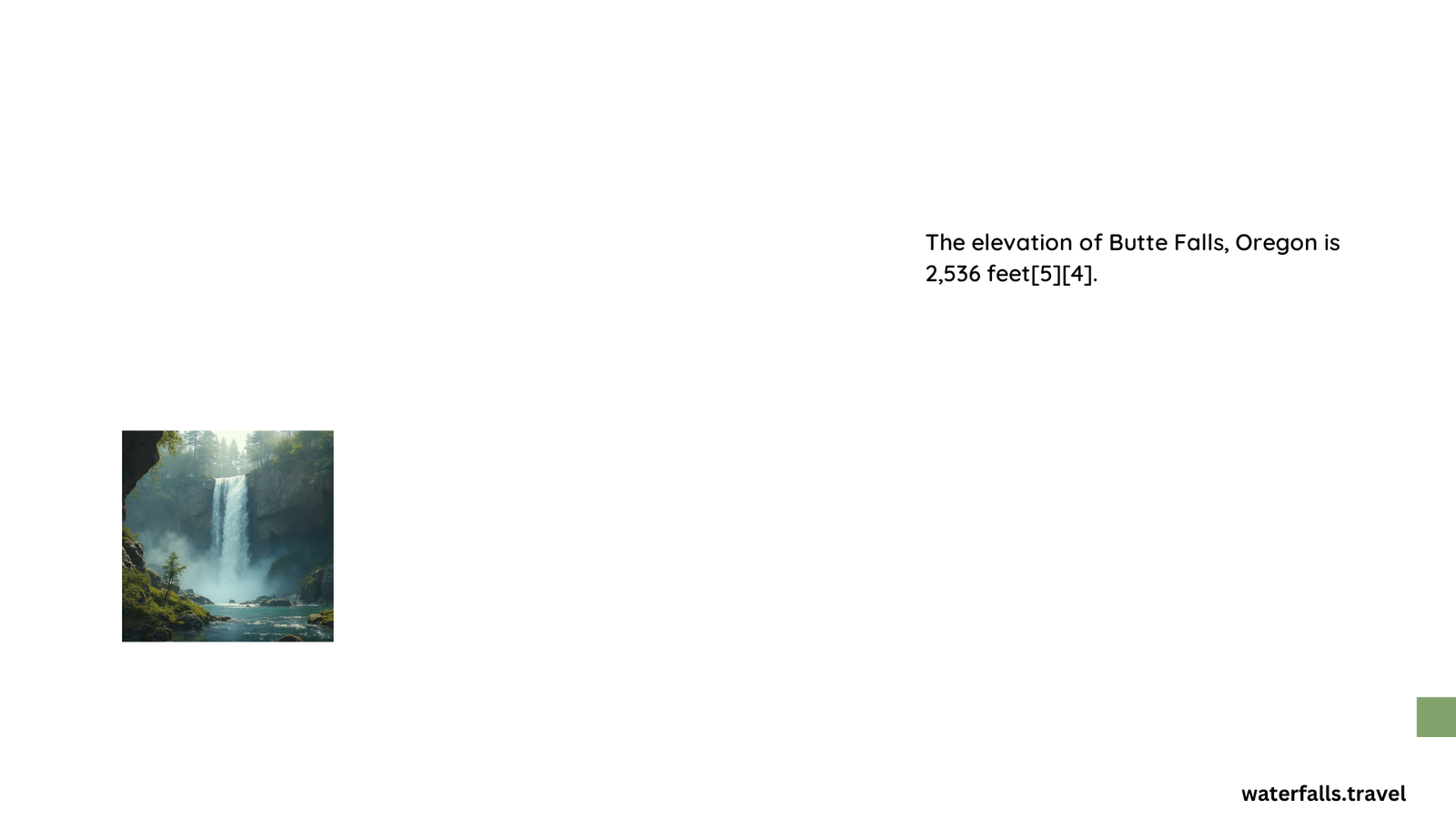Butte Falls, Oregon, is a small town nestled in the Cascade Range, known for its natural beauty and outdoor recreational opportunities. The elevation of Butte Falls varies slightly depending on the source, ranging from approximately 2,358 to 2,600 feet above sea level. This article explores the elevation details of Butte Falls, its surrounding terrain, and related information for visitors and outdoor enthusiasts.
What is the Exact Elevation of Butte Falls, Oregon?
The elevation of Butte Falls, Oregon, is not uniformly reported across all sources. Here’s a breakdown of the elevation data from different references:
- Southern Oregon Profile: Approximately 2,600 feet
- TopoZone Map: About 2,415 feet (736 meters)
- World Waterfall Database: 2,358 feet (asl) for the waterfall itself
These variations might be due to different measurement points or methodologies. For most practical purposes, it’s safe to consider Butte Falls to be at an elevation of around 2,400-2,600 feet above sea level.
How Does the Elevation Affect the Climate in Butte Falls?

The elevation of Butte Falls significantly influences its climate:
- Temperature: Generally cooler than lower-elevation areas nearby
- Precipitation: Higher elevation often leads to increased rainfall and snowfall
- Seasons: Distinct seasonal changes, with potential for snow in winter months
- Vegetation: Supports a mix of coniferous forests typical of higher elevations in the Cascade Range
What Are the Key Topographic Features Around Butte Falls?
Butte Falls is situated in a topographically diverse area. Key features include:
- The waterfall itself, which gives the town its name
- Surrounding forested hills and mountains
- Nearby water bodies like Willow Lake
- Various trails and hiking routes in the state forest
For a detailed view of the topography, refer to the TopoZone map or the USGS map area for Butte Falls, which show contours, elevation points, and other geographic features.
Are There Hiking Trails That Showcase the Elevation Changes?
While specific trail information is limited in the provided sources, the area around Butte Falls likely offers hiking opportunities that highlight its elevation:
- Trails in the surrounding state forest
- Paths near Ernest W. Smith Memorial Park
- Routes around Willow Lake
These trails may offer moderate elevation changes, providing hikers with varied terrain and scenic views. However, for precise trail information, it’s advisable to consult local hiking guides or the Butte Falls Ranger Station.
How Does the Elevation Impact Accessibility to Butte Falls?
The elevation of Butte Falls affects its accessibility in several ways:
- Road Conditions:
- Generally accessible year-round
-
Potential for snow and ice in winter months due to elevation
-
Travel Time:
- Located about 40 miles northeast of Medford
-
Travel time may increase during winter or inclement weather
-
Visitor Preparedness:
- Visitors should be prepared for elevation-related weather changes
- Proper gear and vehicle preparation recommended, especially in winter
What Amenities Are Available at This Elevation?
Despite its elevation and small size, Butte Falls offers several amenities:
- Two restaurants
- A gas station
- A general store
- Picnic supplies for outdoor activities
- Camping facilities near Willow Lake, including RV spaces and cabins
These amenities make Butte Falls a suitable base for exploring the surrounding natural areas at similar elevations.
How Does the Elevation of Butte Falls Compare to Nearby Towns?
To put the elevation of Butte Falls in context, here’s a comparison with some nearby towns:
| Town | Approximate Elevation (feet) |
|---|---|
| Butte Falls | 2,400-2,600 |
| Medford | 1,382 |
| Ashland | 1,949 |
| Crater Lake (rim) | 7,100 |
This comparison shows that Butte Falls sits at a moderate elevation compared to other locations in the region, offering a unique climate and ecosystem.
What Should Visitors Know About the Elevation When Planning a Trip?
When planning a visit to Butte Falls, consider these elevation-related factors:
- Weather Preparation: Pack layers and be ready for cooler temperatures, especially at night
- Physical Fitness: Some visitors may need time to acclimate to the elevation
- Vehicle Readiness: Ensure your vehicle is prepared for mountain driving, particularly in winter
- Outdoor Activities: The elevation provides opportunities for various activities like hiking, fishing, and wildlife viewing
- Photography: The elevation offers unique lighting conditions and scenic vistas
By understanding and preparing for the elevation of Butte Falls, visitors can fully enjoy the natural beauty and outdoor experiences this charming Oregon town has to offer.
